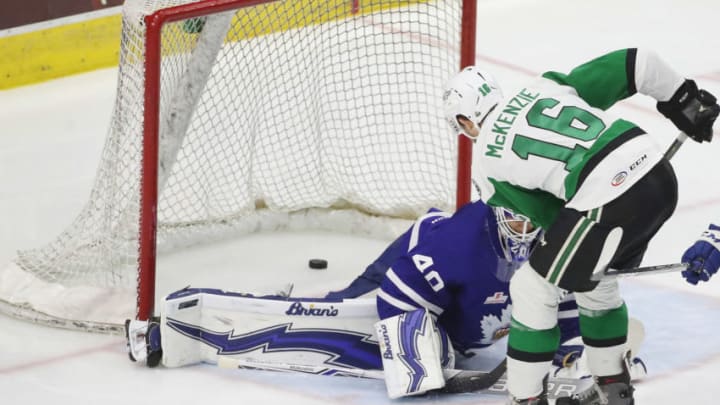Over their century of existence, the Toronto Maple Leafs have become synonymous with losing. Their AHL counterparts, on the other hand, have done just the opposite.
As the final horn brought game two of the Calder Cup Finals to a close, the Toronto Marlies found themselves in a decidedly unfamiliar position.
That being, the wrong side of the scoresheet.
Sunday’s 2-1 defeat at the hands of the Texas Stars marked the team’s first loss since April 27th, surrendered by a lineup bereft of superstars Andreas Johnsson and Travis Dermott. That lapse occurred on the road, aided by the jeers of a raucous Utica crowd. So, while losing has since become a rare phenomenon for the Marlies, losing at home is downright foreign.
In fact, you’d need to travel all the way back to March 24th to find the last time the Ricoh faithful witnessed their team drop one at home.
On paper, the Stars should not be the opponent finding success pushing the Marlies around. In rounds two and three, the Marlies tangled with a pair of 100 point juggernauts of a far higher talent bracket in the Syracuse Crunch and Lehigh Valley Phantoms. Each team housed a necessary and specific facet to give the Marlies a scare.
While Syracuse oozed speed and skill, Lehigh deployed a degree of brute force capable of grinding teams into the dirt.
The Marlies promptly swept them both.
And yet, here sit the Stars, them of 90 regular season points, in a deadlocked series tie at a game apiece.
Let’s unpack why.
Goaltending
Perhaps the majority of the credit falls on the shoulders of Stars goaltender, Mike McKenna.
Over McKenna’s 461 game AHL career, he’s earned himself a .913 save percentage. Fine, for sure. Respectable, even. But certainly not game breaking.
In 2017-18, McKenna didn’t even have the sole grip of the starter’s reigns`. Instead, he found himself thrust into a crease tandem with rookie Landon Bow, finishing the year with a lowly save percentage of .909.
Then, playoff magic kicked in.
In 17 postseason contests, McKenna sits pretty with a record of 12-5, and an eye-popping .933 save percentage to match. The veteran journeyman has captured lightning in a bottle, his unprecedented hot streak carrying his team successfully through 3 playoff rounds and 9(!) overtime contests.
After allowing 6 goals in game one, playoff McKenna showed up for game two.
In a fairly low octane affair – the shots were 24-22 in favour of the Stars – it was the timeliness of his saves which made the difference. Particularly, McKenna’s doorstep denial of Ben Smith in the dying minutes of the third period stood above the rest.
For the Stars to compete with the Marlies offence, an otherworldly performance from their goaltender will be needed.
So far, that’s exactly what they’ve received.
Smothering
The Marlies are a team built on momentum. When they establish a successful and consistent forecheck, there’s really no hope in stopping them.
To counter this, Texas decided that the most optimal strategy was to simply deny them any entry into their zone altogether.
It worked.
Specifically, the Stars’ work in the neutral zone was phenomenal. Whereas the Marlies generally deploy a system beneficial to aggressive attacks off the rush, Texas repeatedly stacked their blueline and eliminated any hope of setting up shop.
Identifying Johnsson as the opposing forward most adept at creating zone entries, the Stars made every effort to take him out of the play. Through constant hits, the mandate on the Texas bench seemed to read “hit number 11”.
As the game wore on, this strategy worked. Through periods two and three, the Marlies managed a combined total of only 9 shots. None of which went in.
Such a strategy is the only way an opponent can deal with the Marlies unrelenting depth. Identify which sequences are their bread and butter, then neutralize the players most capable of executing them.
The Marlies top line of Johnsson, Miro Aaltonen and Carl Grundstrom fit that criteria, and the Stars have held them collectively pointless through the series-opening two games.
Game Three
Games 3-5 of the series now shift to Austin, Texas, where the Stars faithful are expected to come out in full force.
In an atypical move for an AHL team, the Marlies opted to hit the road immediately following game two, in order to acclimatize to their new surroundings.
Remember, these two teams never faced each other in the regular season.
Following their Western Conference Final victory, Texas had an entire weekend to arrive in Toronto, practice on Ricoh ice and get a feel for their temporary workspace. The Marlies are simply striving to afford themselves the same luxury.
In fact, it may be more important than previously thought.
The forecast in Austin calls for temperatures in and around the mid 30’s, inevitably leaving a severe impact on the quality of the ice. For the Marlies to allow themselves ample practice time on that same ice, they’ll be given a chance to adapt to what may be choppy conditions.
This may seem rather irrelevant. But, in the postseason, you take every advantage you can get.
Next: Timothy Liljegren is Not a Project
Game 3 goes Tuesday. The puck drops at 8 pm.
